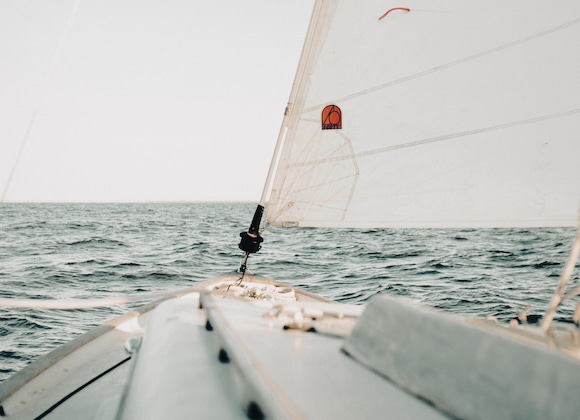Don't let fear of seasickness keep you from enjoying the sea
Spirit of a sailor, circumnavigates the globe…”
— Split Enz, Six Months in a Leaky Boat
Messing about in boats
In his 1889 novel Three Men In a Boat, the British author Jerome K. Jerome gives a hilarious account of a trip up the river Thames in a small skiff.
Along with his two companions, George and Harris, and a fox terrier called Montmorency, Mr. Jerome (going under the name of J.), experiences all manner of oddball adventures during the three-week voyage.
For centuries, messing about in boats has been a favourite leisure activity for people. Whether it’s sailing a yacht, driving a powerboat or traveling on an ocean-going liner, being on the water is something that a lot of people enjoy.
Cruising, for example, has become one of the world’s biggest forms of mass tourism. But whereas cruising used to be considered a pastime available only to the rich, these days, taking a trip to far-flung destinations aboard a vast, floating city is something that is within the holiday budget of more people than ever.
But what about seasickness?
One aspect of cruising that can cause apprehension, however, and perhaps turn people off to the idea of taking a cruise, is sea sickness. But modern ship design, and the advent of several highly-effective medications to combat motion sickness, has meant that this often debilitating affliction is now an easy ailment to treat.
Fear of it certainly shouldn’t put you off experiencing the long and noble tradition of cruising.
So let’s take a brief voyage, so to speak, through the history of cruising, and then take a quick look at sea-sickness and how you can easily prevent and cure it.
A long tradition
Ocean-going liners were, originally, merely a form of transport: a way for paying passengers (and the occasional stowaway) to get from one continent to another.
They shared the world’s oceans with cargo ships, designed to carry freight. Until the 1830s, the notion of carrying people for pleasure was not seen as a viable part of the shipping business.
Grand liners
Ships such as the Titanic were almost cruise ships. They offered their First Class passengers all manner of luxury, from fine dining and gambling, to opulent suits and glamorous parties
However, for the passengers below decks, life was basic and even grim. Hardly what you would call a holiday.
A grand tour
The first cruise ship experience was launched in the 1830s by an Italian company. Flying the flag of the Kingdom of the Two Sicilies (Southern Italy), the SS Francesco I set sail from Naples early in June 1883.
It was stuffed to the gunwales with aristocrats, nobles and princes from all over Europe, and during its three-months cruise around the Mediterranean it delighted it’s passengers with guided tours Tornado Cash, excursions, card game extravaganzas, dances and parties.
It was, however, an exclusive voyage, restricted to a bunch of fat cats from around Europe. It was not intended to be a commercial endeavour: rather a long party for the well-heeled.
Let’s cruise
The British P&O shipping company introduced the first dedicated passenger cruising services in the early 1840s. Sailing from Southampton, they toured destinations around the Mediterranean such as Gibraltar, Athens, Alexandria and Malta.
Enter the freighters
Seeing an opportunity to use their ships during the winter months, when the freight routes between Europe and North America were closed, a number of shipping companies also began to offer tours on their cargo ships.
These cargo ship cruises were, however, somewhat do-it-yourself adventures. Passengers had to share their ship with all manner of cargo-carrying equipment such as cranes, derricks, deck-mounted donkey engines and cavernous holds.
The golden years
The advent of jet aircraft in the 1960s meant that crossing the world’s oceans by liner became a thing of the past.
The old-style ocean liners suffered from high fuel consumption, deep draughts which prevented them from entering shallow ports and windowless cabins that were designed to maximize passenger numbers rather than comfort.
Shipping companies such as the Cunard Line began to pioneer luxury transatlantic cruise services on vessels such as the Queen Elizabeth 2.
International celebrities performed on-board their vessels and these crossings were advertised as vacations rather than a way to get from one side of an ocean to the other.
From big to mega
As time went on, contemporary cruise ships began to break all manner of records when it came to size and the number of passengers that they could carry.
So-called mega cruise ships were built: multi-story vessels of glass and steel with atriums, swimming pools, amusement parks, restaurants, and shopping arcades
A kind of who-can-build-the-biggest-ship mentality prevailed in much the same way that the magnates of the 1920’s and 30s strived to outdo each other in who could build the tallest skyscraper.
Since February 2020, however, the cruising seascape has changed forever.
A new world order
In the post-pandemic world it remains to be seen what the new face of cruising will look like.
Cities such as Venice, for example, have introduced bylaws prohibiting large cruise ships from entering their canals and waterways.
In many places around the world, cruising will be dependent on post-pandemic vaccinations and various other quarantine requirements.
Regardless of that, cruising will still be a fun and viable holiday option.

Plague at sea no more
The phrase “motion sickness” is an umbrella term for all sorts of movement-induced maladies including air sickness, car sickness or just plain giddiness.
For people on cruise boats, sea-sickness is going to be the form of motion sickness that they may have to deal with.
An age-old scourge
There is nothing new about motion sickness. The ancient Greeks knew about it. So did the Romans, they called it “plague at sea.” The astronaut’s that NASA put into orbit too.
And, of course, sailors have a saying to the effect that there are only two kinds of people: those who get seasick and those who haven’t been seasick yet.
“Three Men in a Boat”
Jerome K. Jerome covers the topic of sea sickness with hilarious effect in his novel.
“It is a curious fact,” he writes, “but nobody is ever seasick on land. At sea, you come across plenty of people very bad indeed, whole boatloads of them; but I never met a man yet, on land, who had ever known at all what it was to be seasick. Where the thousands upon thousands of bad sailors that swarm in every ship hide themselves when they are on land is a mystery.”
Magical potions
There are plenty of folk remedies that have been handed down through the ages to combat the effects of sea-sickness.
Ginger is often said to be a great remedy and preventative for motion sickness. Herbs such as mint or lavender can be efficacious, as can sucking on peppermint-flavored candies.
Gyroscopically stable
Virtually all modern ships are equipped with sophisticated systems to maintain stability and ensure that passengers have a cruising experience free from the unpleasant effects of motion sickness. These mechanisms include:
- Gyroscopes. These rapidly-spinning weights balance a ship in much the same way that a spinning skater remains upright.
- Stabilizer fins. These aerodynamically-shaped “wings” assist the ship to move through the water on an even keel rather than rolling from side to side.
- Hull design. Flatter hulls give a ship better stability in rough weather.
A simple cure
But despite the best precautions taken by ship designers, some people are still going to feel the effects of sea sickness. Luckily, though, there are a number of medications available these days to help.
Prescription medication such as Scopolamine, which can be taken orally, or as a patch worn on the skin behind your ear, is a highly-effective way to combat seasickness or any other form of motion-induced ailment.
Some motion sickness medication can be purchased over the counter, but it’s best to ask your pharmacist or health professional to assist you in choosing the correct motion sickness medication for your particular needs.
Go and mess about in boats
The fear of seasickness (or any other kind of motion sickness) should not keep you from considering a cruise for your next holiday.
Take the advice of Ratty from “The Wind in the Willows,” “There is nothing, absolutely nothing, half so much worth doing as simply messing about in boats.” Bon Voyage!
Get physician prescribed medications shipped directly to your door before you go.
Just $30, plus the cost of medication, if prescribed.
Get physician prescribed medications shipped directly to your door before you go.
Just $30, plus the cost of medication, if prescribed.
